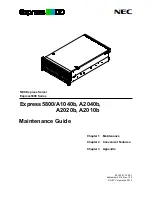184
Routine Maintenance
To clear persistent volume reservations, use this command:
clear (allVolumes | volume [
volumeName
] |
volumes [
volumeName1
...
volumeNameN
]) reservations
Synchronizing the
Controller Clocks
To synchronize the clocks on both controllers in a storage array with the host clock,
use this command:
set storageArray time
Locating Drives
At times, you might need to locate a specific drive. In very large storage array
configurations, this task can sometimes be awkward. If you need to locate a specific
drive, you can do so by turning on the indicator light on the front of the drive. To
locate a drive, use this command:
start drive [
trayID
,
slotID
] locate
To turn off the indicator light after locating the drive, use this command:
stop drive locate
Relocating a Volume
Group
Volume group relocation describes the action of moving drives within the same
storage array. This is a supported capability; however, any relocation of storage array
components must be completed under the guidance of your Technical Support
representative.
This section describes the commands that you use to remove a set of drives and then
reinstall them into a different storage array.
Hot and Cold Volume Group Relocation
There are two methods you can use to move volume groups: hot volume group
relocation and cold volume group relocation.
Hot volume group relocation lets you add or move storage without reconfiguring
the storage array and, in some cases, without rebooting. During hot volume group
relocation, the storage array power is not turned off.
Cold volume group relocation requires that the power to the source storage array
and the destination storage array be turned off before moving the volume groups
from one storage array to another. Then the power to the storage arrays can be
turned on.
To make sure that any volume group being moved to a different destination storage
array is correctly recognized and managed by the new storage array, use hot volume
group relocation whenever possible.
ATTENTION Possible loss of data access
– You must move a single volume group
at a time, and it must go into a storage array with the same level of controller firmware.
Summary of Contents for InfiniteStorage 4000 Series
Page 34: ...22 ExitStatus ...
Page 48: ...36 Adding Comments to a Script File ...
Page 110: ...98 Starting Stopping and Resuming a Snapshot Legacy Rollback ...
Page 168: ...156 Interaction with Other Premium Features ...
Page 182: ...170 Interaction with Other Premium Features ...
Page 192: ...180 SSD Cache Management Tasks ...
Page 216: ...204 RecoveryOperations ...
Page 218: ...206 Show Storage Array ...
Page 219: ...Appendix A Examples of Information Returned by the Show Commands 207 ...
Page 220: ...208 Show Storage Array ...
Page 221: ...Appendix A Examples of Information Returned by the Show Commands 209 ...
Page 222: ...210 Show Storage Array ...
Page 223: ...Appendix A Examples of Information Returned by the Show Commands 211 ...
Page 224: ...212 Show Storage Array ...
Page 225: ...Appendix A Examples of Information Returned by the Show Commands 213 ...
Page 226: ...214 Show Storage Array ...
Page 227: ...Appendix A Examples of Information Returned by the Show Commands 215 ...
Page 228: ...216 Show Storage Array ...
Page 229: ...Appendix A Examples of Information Returned by the Show Commands 217 ...
Page 230: ...218 Show Storage Array ...
Page 231: ...Appendix A Examples of Information Returned by the Show Commands 219 ...
Page 233: ...Appendix A Examples of Information Returned by the Show Commands 221 ...
Page 234: ...222 Show Controller NVSRAM ...
Page 253: ...Appendix A Examples of Information Returned by the Show Commands 241 ...
Page 254: ...242 ShowDrive ...
Page 255: ...Appendix A Examples of Information Returned by the Show Commands 243 ...
Page 256: ...244 ShowDrive ...
Page 257: ...Appendix A Examples of Information Returned by the Show Commands 245 ...
Page 258: ...246 ShowDrive ...
Page 268: ...256 ConfigurationUtility ...
Page 275: ......
Page 276: ...Copyright 2012 NetApp Inc All rights reserved ...


















